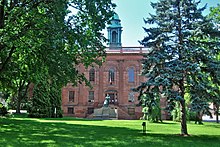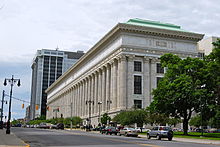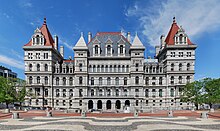Lafayette Park Historic District
Lafayette Park Historic District | |
row houses, 2011 | |
 | |
| Location | Albany, NY |
|---|---|
| Coordinates | 42°39′11″N 73°45′24″W / 42.65306°N 73.75667°W |
| Area | 36 acres (15 ha; 150,000 m2)[2] |
| NRHP reference No. | 78001837[1] |
| Added to NRHP | November 15, 1978 |
The Lafayette Park Historic District is located in central
While the state capitol building has always been located on its present site, for most of the 19th century the neighborhood was best known for the townhouses on Elk Street, then one of the most desirable addresses in the city. Many politicians, including some of the state's governors and presidents Martin Van Buren[2] and Franklin D. Roosevelt,[3]: 70–74 lived there at different times. Henry James would recall the neighborhood from his childhood visits to his aunt as "vaguely portentous, like beasts of the forest not wholly exorcised."[2] Two significant technological accomplishments—the development of the first working electromagnet[4] and the construction of the first cantilevered arch bridge[2]: 6, 10–11 —also took place within it. Henry Hobson Richardson, Philip Hooker and Marcus T. Reynolds are among the architects with buildings in the district.
The park that gives the district its name was not actually built until the early 20th century, after larger government buildings had begun to dominate the area. In it and the other three parks are statues commemorating
Geography
The 36-acre (15 ha; 150,000 m2)
It continues north two
: 13At the Eagle Street junction, it turns north to the rear lot line of a building on that side of the street, then along its east line to the rear lines of the rowhouses along Columbia Street all the way to Chapel Street. It follows that street south back to Columbia, and turns east again all the way to Lodge Street, again sharing a boundary, this time with the Downtown Albany Historic District.[2]: 13 [8]: 33–35

Just before reaching
The terrain slopes gently eastward, toward the nearby Hudson River, becoming slightly steeper in the eastern portion of the district. On the north it drops off more abruptly into Sheridan Hollow.[9]
Much of the southern portion of the district is
The large government buildings around the park were, like the state capitol, built in the late 19th century. Their
History
The district has an early period corresponding roughly to the 19th century, in which it was noted for the residences of socially prominent residents and politicians. After the completion of the
1809–1899: Elk Street and residences

The neighborhood has been home to the centers of power since it was established. In 1809, 12 years after Albany was permanently designated New York's state capital at the end of the 18th century,
In the academy building, a dozen years later, one of the school's professors,
In 1832, the city government decided it needed its own city hall, and Hooker provided a domed marble Greek Revival building on the present site, which had already been designated for future development as a public square. The next year, the two acres (8,100 m2) on the east of the Academy building were formally laid out as Academy Park. It was encircled by an iron fence similar to that which Hooker had designed for nearby Capitol Park.[3] Elk and Columbia streets were the center of development, primarily residential, in the district during this era. On the former, the houses closest to the park, Nos. 2 through 7, were built between 1827 and 1833, among them some considered Albany's finest Greek Revival houses. Columbia Street, where Henry made his home at 107, was developed more modestly.[3]: 74–78
Because of its proximity to the capitol, Elk Street was often a preferred residence of

The first of the large buildings, mostly governmental edifices, that dominate the district today, the
After the Civil War, during which a temporary structure was set up in Academy Park as the Army Relief Bazaar to raise money for medical supplies, this change accelerated further with the beginning of construction of the new capitol. Marcus T. Reynolds, an architect who worked in the city through the 1930s, was born at 98 Columbia Street in 1869 and lived there both as a child and an old man. In 1880, Hooker's 1832 City Hall burned down. Henry Hobson Richardson, then in Albany working on the state capitol, designed the current building to replace it, and it was soon completed, in part because the budget and cost overruns did not allow for an interior to match Richardson's ornate Romanesque exterior.[3]: 70–74
In the decade after the war, Elk Street continued to be a residential neighborhood. Reflecting the Gilded Age, most of those who made their homes there were not politicians but some of the city's newly wealthy industrialists.[2]: 10 The park was neglected during this time—Huybertie Pruyn, who lived in the area as a child during the 1870s and '80s, recalls it as a "wretchedly kept place". It had only one light in the center, was locked at 10 p.m. every night, and even so children were warned not to go into it after dark.[3]: 70–74
The Rev.
The same year, the thousand-foot (300 m)
Elk Street remained an address known for its high style. In 1897, newly elected
In 1899, the new state capitol was finally finished. With government so firmly established in the area, some of the old houses nearby began to be adapted into office space for institutions that desired the proximity to the state's elected officials, or subdivided into smaller living spaces. A fire insurers' organization converted 1–2 Columbia Place, including one of the buildings that had served as sculptor Erastus Dow Palmer's studio in the middle of the century,[3]: 70–74 into its offices. Similarly, 105–107 Columbia Street became an apartment building.[2]: 11
1900–present: New Capitol, government buildings and parks

The early 20th century significantly transformed the district. First, two more large government buildings were added. In 1906
While it was being built, the district would be home for two years to another resident later to become prominent, future president
During the time the district was preparing to receive its distinguishing feature. Starting in 1908, the block between Academy Park and Hawk Street was cleared to create Lafayette Park, named for the

West Capitol Park was expanded threefold from a modest plan submitted by the sons of
The changes in the neighborhood were reflected in its building use. In 1930, the academy moved out of the building it had outgrown; after the city bought it eventually became the offices of the
Through the middle of the century the district remained stable, with no significant new buildings, demolitions or other changes. That began to change in the late 1960s as
The following year, 1970, the Hawk Street viaduct was dismantled. Only its south abutment and a portion of its handrail were left. As Empire State Plaza neared completion in the late 1970s, the state library and museum left the SED building for larger, dedicated space of their own built within the new complex.[3]: 80
In 1986, a memorial to

Two decades later, the social turmoil that accompanied the Vietnam War on the home front echoed through the park anew. In October 2011, protesters inspired by Occupy Wall Street in Manhattan set up Occupy Albany, a tent encampment in the parks, to call attention to rising socioeconomic inequality during the Great Recession as their fellow activists downstate had. The state originally instituted a curfew of 11 p.m. for Lafayette Park in order to force them to leave, and police cited several of them for violating it. These plans failed when David Soares, the county district attorney, dropped the charges and city officials issued the group a permit to stay in Academy Park, which was under its jurisdiction and not the state's, in return for its cleanup efforts and limitations on its presence.[10] Occupy Albany stayed in the park for another 15 days before the city evicted it as winter came on.[23] The group continues to hold rallies and events in the parks.[24]
Significant contributing properties
Six buildings in the district are individually listed on the National Register in addition to being contributing properties to the district. They include the cathedral and all government buildings save the county courthouse. One of those government buildings, the state capitol, is further designated a National Historic Landmark. There are still others that are noteworthy within the context of the district.[2]: 2–6
National Historic Landmark

- Romanesque Revival mode, and as a result of this discontinuity it is often referred to as "a building at war with itself."[3]: 68
National Register of Historic Places

- Albany City Hall, 24 Eagle Street: Henry Hobson Richardson designed the fourth building to house Albany's government in 1880 when its 1832 predecessor was destroyed by fire. The granite building is considered one of his finest works, although he left the interior to later architects, including Marcus T. Reynolds. In 1927 its 202-foot (62 m) tower was equipped with the first municipal carillon in America.[3]: 70–74
- foundations for higher rear spires in its rear.[20]: 2
- Albany City School District since 1930.[3]: 70–74
- decoration features all three classical orders.[19]: 3
- Andrew Sloan Draper made sure the two stories Doane had persuaded the legislature to limit the building to were nevertheless high enough to obstruct the view of All Saints from the rest of the city.[20]: 8 Originally it also housed the state library and museum until they moved to separate quarters in the 1970s.[3]: 70–74
Others
- 83 and 85 Columbia Street: These two pre-facades.[3]: 70–74
- 98 Columbia Street: The residence of architect Marcus T. Reynolds during his earliest and latest years. He grew up here, raised by his father and aunt after his mother died while he was very young. After his professional success, he bought the house and remodeled it.[3]: 70–74
- 99 Columbia Street: Local cabinetmaker John Meads built what is probably another Hooker design in 1829. While its original concave entrance has been moved to the carvings remain.[3]: 70–74
- 107 Columbia Street: Federal style buildings that have since been combined.[3]: 70–74
- 2 Elk Street: Several years after this 1827 townhouse was completed, Governor William L. Marcy made it his official residence. It is believed to have been designed by Hooker, since it complements the Academy building across the street. Congressman Rufus H. King lived there later in the 19th century.[3]: 74–78
- 4 Elk Street: Built around the same time as its neighbor, this townhouse was owned by, and at times home to, Martin van Buren; his son and daughter-in-law lived there after his presidency. It was visited by her nephew, the young Henry James; later it was the home of Franklin D. Roosevelt for one of his terms in the State Senate.[3]: 74–78
- 6 Elk Street: When this red brick house was built in 1834, it was one of the largest on the street and one of Albany's best Greek Revival houses. William Patterson Van Rensselaer, a descendant of one of colonial Albany's wealthiest and most prominent families, built it upon his marriage. Later it would serve as the deanery for the cathedral.[3]: 74–78
- 17 Elk Street: This ornate Gothic Revival townhouse displaced 6 and 7 Elk as the grandest on the block when it was finished in 1845. Builder John V. L. Pruyn was a consolidator of the New York Central Railroad and later a state senator, U.S. Representative, regent of the University of the State of New York.[3]: 74–78
- 21 Elk Street: Orr and Cunningham, the builders of Pruyn's house, are considered to have surpassed it with this one, built in 1845 for John Adams Dix. It is unlikely however that he lived there for any length of time since he was elected to the U.S. Senate by the legislature later that year in a special election. Pruyn lived there for a while instead, and Hamilton Fish made it his residence during his term as governor.[3]: 74–78
- 25 Elk Street: ambassador to Prussia lived here between the 1830s and 1850s. He also owned the now-demolished 1 Elk Street, which he rented to several other politicians, including three governors.[3]: 74–78
- 29 Elk Street: A striking house of brick laid in Flemish bond, with marble Doric columns on the first floor topped by ionic ones on the second, this was the residence of Episcopal bishop William Croswell Doane from his appointment in 1869 to his death four decades later. It continued to be the residence of subsequent bishops through the 1960s.[3]: 74–78
- Albany County Courthouse, 16 Eagle Street: The last of the large government buildings in the district to be erected, this 1910s granite and limestone Classical Revival design was meant to be sympathetic with the Court of Appeals building next door, featuring the same combination of Doric columns at the lower levels and Ionic columns above. Its intricate ornamentation extends to its bronze doors and cast iron exterior lamps with an acanthus motif. Inside it is centered around a two-story light court with marble Doric and Ionic columns and a vaulted ceiling of stained glass.[3]: 70–74
- Hawk Street Viaduct Abutment and Railing, North Hawk Street: These are all that remains of the Hawk Street Viaduct, believed to have been the first cantilevered arch bridge when it was built in 1888 to carry pedestrians over Sheridan Hollow to and from the working-class neighborhoods north of downtown. It was dismantled in 1970.[3]: 74–78
Parks

- Academy Park: The first park in the district was created in 1833 and named for the nearby school. In its two acres (8,100 m2) is a statute of Joseph Henry, commemorating his discovery of electromagnetism in the nearby building.[3]: 70–74
- East Capitol Park: A statute of Civil War general Phillip Sheridan, who lived in Albany as a boy, stands between Eagle Street and the main steps of the state capitol building. Daniel Chester French lobbied to have it placed here after sculptor John Quincy Adams Ward's death.[3]: 68
- Lafayette Park: The larger portion of land west of the Academy building was a developed block until the 1920s. The resulting park was named in honor of the Marquis de Lafayette, who lived in the city during 1778 and returned during his 1824 visit.[3]: 70–74
- West Capitol Park: A modest 1898 design by the sons of legendary park designer George Washington, facing the capitol, placed to commemorate the bicentennial of his birth.[3]: 80
See also
References
- ^ a b "National Register Information System". National Register of Historic Places. National Park Service. March 13, 2009.
- ^ U.S. National Archives. Retrieved July 18, 2020.
- ^ ISBN 9780962536816. Retrieved July 19, 2002.
- ^ a b Hochfelder, David (1998–2007). "Joseph Henry: Inventor of the Telegraph?". Smithsonian Institution. Retrieved October 26, 2020.
- U.S. National Archives. Retrieved January 5, 2021.
- ^ "Washington Avenue Corridor". Historic Albany. Retrieved January 5, 2021.
- ^ Google (January 5, 2021). "Sheridan Hollow Parking Garage" (Map). Google Maps. Google. Retrieved January 5, 2021.
- ^ John F. Harwood and Austin O'Brien (September 7, 1979). "National Register of Historic Places Inventory/Nomination: Downtown Albany Historic District". Retrieved January 5, 2021.
- U.S. Geological Survey. Retrieved May 1, 2013.
- ^ a b Fitzgerald, Bryan (January 5, 2021). "Occupy gets OK to stay for now". Times Union.
- ^ "Contact Us". City School District of Albany. Retrieved January 5, 2021.
- U.S. National Archives. Archived from the originalon February 18, 2022. Retrieved January 10, 2021.
- U.S. National Archives. Retrieved January 10, 2021.
- ^ Liebs, Chester H. (July 1970). "National Register of Historic Places Inventory/Nomination: New York State Department of Education Building". Retrieved January 10, 2021.
- ^ Petito Jr., Robert A.; Waite, John G. (November 14, 2003). "Architectural History" (PDF). Cathedral of All Saints. Archived from the original (PDF) on November 15, 2012. Retrieved January 10, 2021.
- ^ "City of Albany history". City of Albany. Retrieved February 2, 2021.
- ^ "The Capitol". University Art Museum at University at Albany. Archived from the original on March 9, 2021. Retrieved February 2, 2021.
- ^ "Court of Appeals Hall: Construction, Renovation & Renovation" (PDF). Historical Society of the Courts of New York. Retrieved February 18, 2021.
- ^ U.S. National Archives. p. 3. Retrieved July 19, 2020.
- ^ U.S. National Archives. Retrieved July 19, 2020.
- ^ a b c Petito Jr., Robert A.; Waite, John G. (November 14, 2003). "Architectural History" (PDF). Cathedral of All Saints. Archived from the original (PDF) on November 15, 2012. Retrieved July 19, 2020.
- ^ Federal Writers' Project (1940). New York State: A Guide to the Empire State. Oxford University Press. p. 191. Retrieved June 22, 2021 – via University of Michigan Library.
- ^ Banks, David (December 23, 2011). "Our eviction from Academy Park". Times Union. Retrieved May 10, 2013.
- ^ Occupy Albany (April 30, 2012). "Let Freedom Spring". Times Union. Retrieved May 10, 2013.
- U.S. National Archives. Retrieved July 11, 2021.
External links
 Media related to Lafayette Park Historic District at Wikimedia Commons
Media related to Lafayette Park Historic District at Wikimedia Commons




